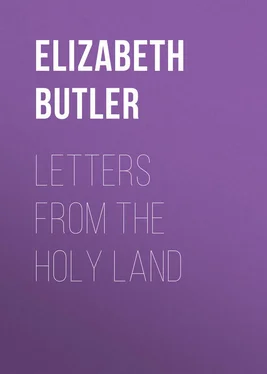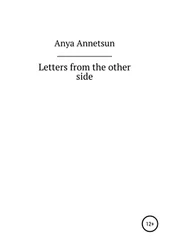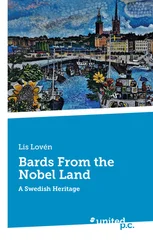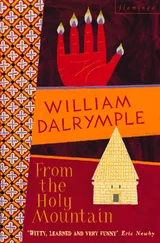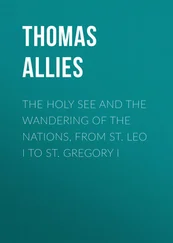Elizabeth Butler - Letters from the Holy Land
Здесь есть возможность читать онлайн «Elizabeth Butler - Letters from the Holy Land» — ознакомительный отрывок электронной книги совершенно бесплатно, а после прочтения отрывка купить полную версию. В некоторых случаях можно слушать аудио, скачать через торрент в формате fb2 и присутствует краткое содержание. Жанр: foreign_antique, foreign_prose, на английском языке. Описание произведения, (предисловие) а так же отзывы посетителей доступны на портале библиотеки ЛибКат.
- Название:Letters from the Holy Land
- Автор:
- Жанр:
- Год:неизвестен
- ISBN:нет данных
- Рейтинг книги:4 / 5. Голосов: 1
-
Избранное:Добавить в избранное
- Отзывы:
-
Ваша оценка:
- 80
- 1
- 2
- 3
- 4
- 5
Letters from the Holy Land: краткое содержание, описание и аннотация
Предлагаем к чтению аннотацию, описание, краткое содержание или предисловие (зависит от того, что написал сам автор книги «Letters from the Holy Land»). Если вы не нашли необходимую информацию о книге — напишите в комментариях, мы постараемся отыскать её.
Letters from the Holy Land — читать онлайн ознакомительный отрывок
Ниже представлен текст книги, разбитый по страницам. Система сохранения места последней прочитанной страницы, позволяет с удобством читать онлайн бесплатно книгу «Letters from the Holy Land», без необходимости каждый раз заново искать на чём Вы остановились. Поставьте закладку, и сможете в любой момент перейти на страницу, на которой закончили чтение.
Интервал:
Закладка:
At 9.30 we left the plain and at once entered the hills of Judea, which are much more uniformly stony than one would suppose them to be from a distance. We soon stopped at a wayside khan, about half-a-dozen Vetturinos being assembled in the yard, and all the horses were rested. We then began the ascent of the dear Hill Country, fragrant with memories of Mary on her journey made in haste from Nazareth. I did not expect such a long and high ascent, having failed to realise from description the immense altitude of the height of land that holds Jerusalem. “Things seen are mightier than things heard.” The wildflowers increased in beauty and variety, chief, I think, amongst them being the crimson anemones with black centre which tossed their gay heads everywhere in the mountain breeze. Olives and stones, stones and olives on all sides. Here and there a carob tree or a clump of tamarisk at a tomb. As we crested the first pass and looked back we saw the plains of Philistia, with Ramleh white in the sunshine and the sea beyond shining in a long flash of silver. Before us to the right soon loomed against the clouds the great tombs of the Maccabees, and away to our left on a high cone appeared, remote and awful, the “Tomb of Samuel,” a dominating feature over all the land.
As we descended on the other side of the pass we came in sight of Ain Kareem, the reputed birthplace of John the Baptist, on the side of a high hill. The words of the Magnificat sounded in one’s mind’s ear. It is a grand situation and most striking as seen from the road. At the bottom of the valley formed by the hill we were descending and the hill of Ain Kareem runs the dry bed of the brook from which David chose his smooth stone for Goliath. W. went down and selected just such a smooth white stone as a memento. At the bottom of the valley we halted at a Russian khan and I took a little sketch of a bit of hillside and a pear-tree in blossom. You must have seen this land with “second sight,” for you have always seen a flowering fruit-tree in your mental pictures of it at Eastertide and Lady Day. Palestine is essentially the land of little fruit-trees.
On leaving the Russian khan, where we beheld chromo-lithographs of the late and the present Czars on the walls, and were interested in the high Muscovite boots of our host, we had another great ascent, and soon after reaching the top my feelings became more and more focussed on the look-out ahead. I saw signs that we were approaching Jerusalem. There were more people on the road, and a detachment of the Salvation Army was marching along with a strangely incongruous appearance. Yet only incongruous on account of the dress, for, morally, those earnest souls are amongst the fittest to be here. I stood up in the carriage, but W. from the box saw first. He raised his hat, and a second after I had the indescribable sensation of seeing the top of the Mount of Olives, and then the Walls of Zion! It was about three o’clock.
We left the carriage outside the Jaffa Gate, for no wheeled vehicle can traverse the streets of Jerusalem, and we passed in on foot.
We had first to go to the hotel, of course, a very clean little place facing the Tower of David. Thence we soon set out to begin our wonderful experiences.
I had what I can only describe as a qualm when we reached, in but a few hundred steps, the Church of the Holy Sepulchre. It was all too easy and too quick. You can imagine the sense of reluctance to enter there without more recollection. I had a feeling of regret that we had not waited till the morrow, and I would warn others not to go on the day of arrival. We reached the Church through stone lanes of indescribable picturesqueness, teeming with the life of the East, and there I saw the Jerusalem Jews I had so often read of – extraordinary figures in long coats and round hats, a ringlet falling in front of each ear, while the rest of the head is shaved. They looked white and unhealthy, many of them red-eyed and all more or less bent, even the youths. No greater contrast could be seen than between those poor creatures and the Arabs who jostle them in these crowded alleys, and who are such upstanding athletic men, with clear brown skins, clean-cut features, and heads turbaned majestically. They stride along with a spring in every step. There are Greeks here, and Russians in crowds, and Kurds, Armenians, and Kopts – in fact samples of all the dwellers of the Near East, wearing their national dresses; and through this fascinating assemblage of types and costumes, most distracting to my thoughts, we threaded our way to-day, ascending and descending the lanes and bazaars, up and down wide shallow steps, till we came in front of the rich portal of the Church of churches. With our eyes dazzled with all that colour, and with the sudden brilliance of the sunshine which flooded the open space in front of the façade, we passed in! Do not imagine that the church stands imposingly on an eminence, and that its proportions can strike the beholder. You go downhill to it from the street, and it is crowded on all sides but the front by other buildings. But its gloomy antiquity and formlessness are the very things that strike one with convincing force, for one sees at once that the church is there for the sake of the sites it encloses, and that, therefore, it cannot have any architectural symmetry or plan whatever, and its enormous extent is necessitated by its enclosing the chapels over Calvary and the Holy Sepulchre and many others besides, which the Empress Helena erected over each sacred spot whose identity she ascertained with so much diligence. It is very natural to wish that Calvary was in the open air, – lonely, under the sky that saw Christ suffer on the Cross. But already, in the year 326, St. Helena found the place of execution buried under mounds of rubbish purposely thrown upon it; and where would any trace of it be to-day had she not enclosed it – what with man’s destroying acts and the violence of the storms that have beaten against this rock for nineteen centuries and more? It was, to begin with, but a small eminence close outside the walls. On entering the church you discern in the depths of the gloom of the tortuous interior the rough steep steps cut in the rock that lead to Calvary, on your right hand. On climbing to the top, groping in the twilight, you find yourself in a chapel lined with plates of gold and hung with votive lamps. The sacred floor, which is the very top of Calvary, is entirely cased in gold, and under the Greek altar is shown the socket of the Cross, a hole in the rock. Our altar stands to the proper left of the Greek, which has the post of honour. Descending from Calvary there is a long stretch of twilight church to traverse before we come to the sepulchre. Again I had not realised, from the books I have read, the great distance that separates the two, and, indeed, many writers in their scepticism have done their best to belittle the whole thing. I confess that before to-day I was much under the influence of these writers, but I have now seen for myself, a privilege I am deeply thankful for. It was an overwhelming sensation to find the spaces that separate the sites so much vaster than I had expected, and to have, at every step, the conviction driven home that after all the modern wrangling and disputing the old tradition stands immovable. It certainly would be hard to believe that when St. Helena came here the dwellers of Jerusalem should have lost all knowledge of where their “Tower-hill” stood in the course of three centuries. She was commissioned, as you know, by her son the Emperor Constantine, that ardent convert to Christianity, to seek and secure with the utmost perseverance and care all the holy sites, and to her untiring labours we owe their identification to this day. The great central dome of the church rises above the chapel of the Holy Sepulchre, which chapel stands in the vast central space, a casket enclosing the rock hollowed out into Our Lord’s Tomb and its ante-chamber. You enter this ante-chamber and, stooping down, you pass on your hands and knees into the sepulchre itself. On your right is the little low, rough-hewn tomb, covered with a slab of stone worn into hollows by the lips of countless pilgrims throughout the long ages of our era. A monk keeps watch there, and beside him there is only space enough for one person at a time. I have made many attempts to tell you my thoughts and feelings during those bewildering moments of my first visit, but I find it is impossible, and you can understand why.
Читать дальшеИнтервал:
Закладка:
Похожие книги на «Letters from the Holy Land»
Представляем Вашему вниманию похожие книги на «Letters from the Holy Land» списком для выбора. Мы отобрали схожую по названию и смыслу литературу в надежде предоставить читателям больше вариантов отыскать новые, интересные, ещё непрочитанные произведения.
Обсуждение, отзывы о книге «Letters from the Holy Land» и просто собственные мнения читателей. Оставьте ваши комментарии, напишите, что Вы думаете о произведении, его смысле или главных героях. Укажите что конкретно понравилось, а что нет, и почему Вы так считаете.
